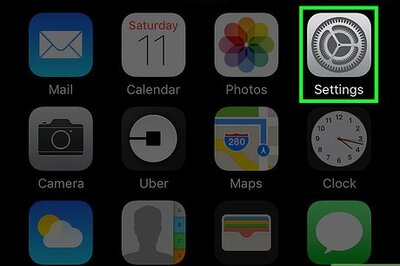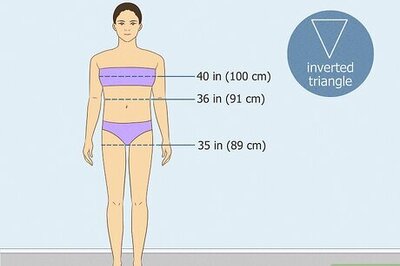
views
Meal Plans for 140 Grams of Daily Protein
Breakfast Aim to get around 35 grams of protein (or 47 grams if you don’t plan on snacking during the day) at breakfast to help start your day right. Opt for high-protein breakfast foods like eggs, cheese, tofu, black beans, Greek yogurt, cottage cheese, and oatmeal. Scrambled eggs: Scramble eggs with some spinach. Pair it with 2 slices of whole-wheat toast and 2 slices of bacon. (32 grams of protein) Tofu scramble: Crumble and heat tofu with spinach, bell peppers, and tomatoes. Serve with potatoes and 2 slices of whole-wheat toast. (33 grams of protein) Greek yogurt: Add Greek yogurt, oats, chia seeds, and a splash of milk to a bowl. Top with nuts, seeds, and fruit for more protein. (31 grams of protein) Oatmeal: Cook rolled oats and add whey, pea, or hemp protein powder and chia seeds. Top with milk, sliced banana, and cinnamon for extra protein and flavor. (35-45 grams of protein Protein pancakes: Mix together whole wheat flour, milk (powdered, soy, oat), and 1 egg. Cook the batter in a pan. Then, top with walnuts. (35 grams of protein) For a lower-carb alternative, certified dietician-nutritionist Lisa Jubilee recommends using almond, coconut, or cassava flour.
Lunch Get around 35 grams of protein (or 47 grams if you skip snacks) at lunchtime, too. Choose healthy and delicious sources of protein like beans, lentils, quinoa, lean meats (chicken, turkey), and fish (tuna, salmon). Tuna salad sandwich: Mix canned tuna with celery, lemon juice, and mayonnaise. Spread it on 2 slices of whole-wheat bread and add a large piece of lettuce. (27 grams of protein) Serve with a chickpea and veggie salad. (10 grams of protein) Plant-based grain bowl: Add cooked quinoa, chickpeas, kale, roasted veggies (cauliflower, broccoli, sweet potato), and tahini dressing to a bowl. (20 grams of protein). Add another protein source like tofu, tempeh, or seitan to boost your intake. Chicken lettuce wrap: Cook ground chicken with mushrooms, garlic, and ginger. Then, pour in a soy sauce marinade. Spoon the chicken onto a leaf of lettuce. (24 grams of protein) Serve with ½ cup of brown rice. (7 grams of protein) Vegetarian/vegan tacos: Crumble and coat tofu with taco seasoning. Then, bake it until crispy. Top a warm corn or flour tortilla with the tofu, black beans, and your favorite toppings. (20 grams of protein) Turkey wrap: Fill a flour or gluten-free tortilla with sliced turkey deli meat, cucumber, tomatoes, romaine lettuce, cheddar cheese, and Greek yogurt. (28 grams of protein)
Dinner Eat about 35 grams of protein (or 47 grams if you skip snacks) at dinner to fulfill your protein intake. Like at lunch, prioritize lean meats, fish, tofu, tempeh, seitan, and grains like quinoa. Chicken stir-fry: Stir-fry chicken and zucchini in a pan. Then, pour in a soy sauce marinade. Serve over whole grain or brown rice. (40 grams of protein) Salmon and sweet potato: Roast salmon and broccoli in the oven. Serve with mashed sweet potato. (32 grams of protein) Turkey burger: Form minced turkey into patties and bake. Add your favorite toppings and serve with roasted veggies, like sweet potato or broccoli. (40 grams of protein) Creamy vegan pasta: Sauté onions, bell peppers, sun-dried tomatoes, and garlic in a pan. Add tomato paste, spices, and a creamy cashew sauce. Toss with lentil pasta and spinach. (36 grams of protein) Lentil and cauliflower curry: Simmer the lentils in vegetable stock with cauliflower and potatoes. Serve over brown or whole grain rice. (23 grams of protein)
Snack Get an additional 35 grams of protein by snacking on nutritious foods throughout the day. Some great options include nuts, cottage cheese, yogurt, hummus, and peanut butter. Almonds: ¼ cup has about 6 to 15 grams of protein. Roasted chickpeas: ½ cup has about 7 grams of protein. Cottage cheese: ½ cup with fruit on top has about 10 grams of protein. Greek yogurt: ⅔ cup with fruit on top has about 20 grams of protein. Hummus: ¼ cup of hummus with raw veggies has about 5 grams of protein. Hard boiled eggs: 1 egg has about 6 grams of protein. Peanut butter (with apples or celery): 1 tbsp has about 8 grams of protein. String cheese: 1 stick has about 7 grams of protein. Protein shake: 1 scoop of protein powder has 10-20 grams of protein. For a nutrient boost, certified nutrition and wellness consultant Lyssandra Guerra recommends adding spinach, baby kale, tahini, Medjool dates, coconut water, and coconut cream. Protein bar: Most bars have around 10 grams of protein. ACE-certified personal trainer Monica Morris agrees that protein bars are a great way to get extra protein.
Ways to Increase Protein in Your Diet
Eat foods high in protein at every meal. Ensure you’re getting healthy, high-quality sources of protein at breakfast, lunch, dinner, and while you snack. Some great options include poultry, fish, eggs, nuts (peanuts, almonds), seeds (chia, hemp), beans (black, garbanzo), lentils, grains (quinoa, buckwheat), dairy (yogurt, cottage cheese), and soy products (tofu, tempeh). Whenever possible, Registered dietician and personal trainer Melody Sayers recommends that you “choose fish, beans, or lentils as your protein source.” She says, “Fish is high in healthy fats, such as Omega 3s” while “plant-based protein contains fiber, is free of cholesterol, and contains virtually no saturated fat.” Most dieticians don’t recommend getting the majority of your protein from red meat. Sayers says beef and pork are “much higher in saturated fat, sodium, and cholesterol” than lean animal proteins like chicken, turkey, and fish. However, it’s fine to enjoy red meat in moderation. Just look for grass-fed meat that has a high lean meat percentage to make a healthier choice.
Split your protein intake across 3 to 5 meals. Your body can only process so much protein at one time. So, don’t eat all of your protein in one sitting. Morris recommends splitting your daily protein intake over 3 to 5 meals, including breakfast, lunch, dinner, and snacks. So, aim to get 28 to 47 grams of protein at each meal if your goal is to get 140 grams of protein each day. Morris says, “If someone were to try and intake their [protein] portion in a shorter period of time, that remainder generally will go to fat storage or waste products” instead of being absorbed by your body.
Eat protein first at each meal. Digging into your proteins and veggies before you get to the carbs slows your digestion and helps you feel fuller for longer. This also helps reduce spikes in blood sugar, which is great for those who are diagnosed with diabetes or pre-diabetes. Eating your proteins first is also great if your goal is also to lose weight.
Switch out foods and ingredients for high-protein alternatives. For instance, nutrition and vegan food specialist Dee Dine recommends replacing pasta and noodles made from refined white flour with high-protein alternatives made from buckwheat, lentils, or chickpeas. Swap out white rice for quinoa, bulgur, amaranth, or couscous. When making salads, top them with nuts, seeds, and beans instead of croutons for a similar satisfying crunch.
Opt for protein supplements when you’re in a pinch. Morris says protein powder and protein bars are a great, quick way to boost your protein intake. For instance, she suggests making protein shakes with protein powder or adding it to oatmeal, coffee, and even water. For a vegan alternative to whey protein powder, opt for hemp, pea, or soy protein. In particular, Dine says “hemp protein powder offers many nutritional benefits.” She says: “It offers a complete protein” to support the “major organs, including the brain.” It’s also “useful for weight control as it helps regulate the metabolism” and “keeps blood sugar levels balanced.” It is “full of antioxidants which boost the immune system” and “high in unsaturated fats which are healthy for the heart.”
Plan out your meals for each week. Before you go grocery shopping, write down all the meals you plan on making that week and the ingredients you need to make them. This helps ensure that you hit your protein goals each day. As a plus, making a meal plan and grocery list can prevent you from making impulse buys, which can help you save money. Cook more at home instead of eating out at restaurants so you know exactly how much protein you’re getting. Registered dietitian and nutritionist Jalpa Sheth says cooking at home is “a lot healthier” because “you can control the ingredients…as well as the portions and the way it's cooked.”
Track your protein intake with a food-tracking app. Using a food-tracking app is a great way to ensure you’re hitting your protein goals and getting other important nutrients. Personal trainer John Diaz says, “I personally use a food tracker” to track “every calorie, every gram of fat, protein, carbohydrate, and fiber that I eat every day” which “works really well to keep me on track.” For instance, try an app like MyFitnessPal or Cronometer.
Maintain a healthy, balanced diet. Protein is just one component of a healthy, balanced diet. Ensure you’re getting plenty of vegetables, fruits, whole grains, and unsaturated fats (olive oil, avocados) to stay healthy and full of energy. In general, about ½ of each meal should be veggies/fruits, ¼ should be protein, and ¼ should be whole grains.
Inexpensive and Healthy High Protein Foods
Meat-based protein There are plenty of inexpensive meats that give you a great amount of protein. In general, stick to leaner cuts, which are also usually healthier and contain fewer calories, saturated fats, and sodium. Chicken breast (100 grams): 22.5 grams of protein Ground turkey (100 grams): 17.3 grams of protein Ground pork (100 grams): 17.8 grams of protein Canned tuna: 19 grams of protein Wild salmon (100 grams): 22 grams of protein
Plant-based protein Plant-based proteins are generally less expensive than meat, so they’re a great way to hit your goals while saving money. Some options include: Black beans (100 grams): 24 grams of protein Chickpeas (100 grams): 21 grams of protein Lentils (100 grams): 23 grams of protein Tempeh (100 grams): 20 grams of protein Tofu (100 grams): 8 grams of protein Peanuts (100 grams): 23 grams of protein Quinoa (100 grams): 12 grams of protein
Dairy products Lots of dairy products are full of protein. Some inexpensive options include: Greek yogurt (100 grams): 9 grams of protein Cottage cheese (100 grams): 11 grams of protein String cheese (100 grams): 31 grams of protein Skim milk (100 grams): 3 grams of protein Soy milk (100 grams): 3 grams of protein
Vegetables Many vegetables are a good source of protein, as well as other important nutrients. Check out these inexpensive and healthy options: Brussels sprouts (100 grams): 4 grams of protein Corn (100 grams): 3 grams of protein Russet potatoes (100 grams): 2 grams of protein Broccoli (100 grams): 2 grams of protein Asparagus (100 grams): 1 gram of protein
How much protein do I need per day?
Eat 0.36 grams of protein per pound you weigh (or 0.8 grams per kg). This is generally the amount of protein you need each day to meet your basic protein requirements. However, the specific amount you need depends on your activity level, age, weight, and sex. For instance, someone who is 170 lbs (77 kg) needs about 61 grams of protein each day to meet their minimum requirement. According to Sheth, “different phases of life [have] different demands of protein.” She says, “When you are in your adulthood, it goes by how active you are.” And when you are older, the protein demand is higher “because your body needs more to…keep up its muscle mass.” If you’re not sure how much protein you need, consult your doctor or a registered dietician. They can also help you come up with a plan to ensure you meet your protein requirements.



















Comments
0 comment